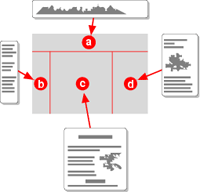I’m happy to announce the latest project I’ve been working on:
A jQuery plug-in to provide support for the CSS Template Layout Module. For those of you unfamiliar with this specification, it provides a relatively easy way to make a table-like layout using CSS. Until recently it was known as the “CSS Advanced Layout Module”.
The spec is still a “working draft”, so it can still change significantly. But while that status hasn’t stopped browsers from implementing other CSS3 modules, so far none have tried implementing this one.
Inspired by Eric Meyer‘s Call for a layout system as well as his suggestion that many CSS features can be made to work using JavaScript, I went to work. Why wait for browsers to implement something when we can have JavaScript take care of it today?
The advantages to using this system include:
- Source independence, so there’s lots of possibilities with the same markup
- All the benefits of a table-like design without the drawbacks
- Instant overview of how the basic layout works just by looking at the CSS
- No need for div-heavy CSS frameworks just to accomplish a simple design
- Easy rearranging for different media (print, mobile)
The disadvantage to using JS rather than native support means of course that those with JavaScript disabled won’t see the intended layout. However, considering the HTML content can me put in almost any order, there is still a lot of flexibility in how it will appear to non-JS users.
The script has been tested and confirmed to work in the following browsers:
- Internet Explorer 7+
- Firefox 2+
- Opera 9.6+
- Safari 3.1+
- Chrome 1+
For download, demos, and usage, see the Project page. Contributions welcome!

